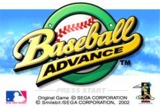I decided to check out Sega’s offering
Although the features and managerial options are not very plentiful, Baseball Advance really shines in the most important place: an actual game. Smile Bit gives an equal balance to each of the main parts of America’s Favorite Past-Time, and they each come out great, some better than others.
The batting interface was something that I was not used to from other games. You have a cursor that you move around to aim at a pitch like most games, but you must hold down the swing button to charge up the power of the swing and then let go at the right time to hit the ball. It works well, and it is a great way to incorporate power swings into the game. Based on where the ball is in relation to the cursor icon decides if it’s a ground ball, pop up, or hit to the left or right. The game is more action-oriented, so hits are thankfully easy to come by. I was also thankful that the other team’s pitching seemed human. Patience is key, as they will hand out walks and even hit you with the pitch at times. My only gripe is that batting can sometimes feel more like luck than something that requires skill, and hopefully Smile Bit can work on this for next season.
Pitching is a very quick process, and helps the game’s arcade feel. Select a pitch by pressing a direction on the D-Pad, press A to confirm it, and quickly aim the pitch during your pitcher’s wind up. As your pitcher gets tired, you’ll notice his accuracy will diminish and the other team will hit him harder. You can of course make pitching changes at any time, and you do not need to warm a pitcher up first. The other team’s batters have good AI. They don’t always hit the ball; they don’t always strike out. Pitching isn’t quite as fun as batting, but it’s well done.
Fielding is a weakness, but it is not as poor as in All-Star Baseball 2003. When the ball it hit, an icon appears where it will land. The game generally picks the right fielder for the job, and he can move pretty fast. Dives are easy to perform and help add excitement to the game (although it’s not a good idea to dive for everything as players can be injured). My main complaint with fielding is, on fly balls, the camera locks onto the ball instead of where the ball is going to land. Usually the ball will hang up long enough so that you can make the play, but sometimes you’ll miss the ball completely thanks to the system. Fielding AI is decent as long as you’re on at least the Veteran difficulty level.
My main complaint with ASB 2003’s base running was that it was too slow. In Baseball Advance, it’s almost too fast. You’ll be surprised at how quickly players move around the bases, but this helps add to its arcade feel. The speed allows you to make great base-running feats such as the always awesome inside-the-park homerun. Base running movement is also very intuitive, with the L button advancing runners and the R button returning them to the previous base. Taking leads and stealing bases is just as easy. Base running AI is never a problem, as they are aggressive enough to make fielding much more fun.
In between levels, Baseball Advance greets you with music; the runs, hits, and errors of the game; and scores of other games around the league. The latter is a very cool feature because you can keep tabs on your bitter enemies of the season during each game. That’s sure to keep you competitive!

